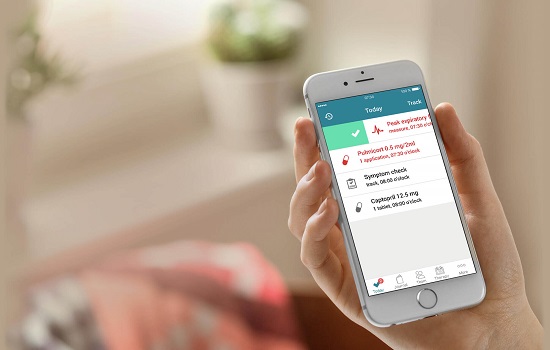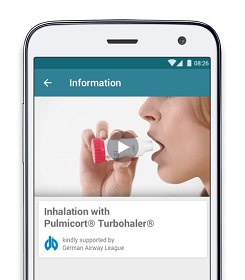Coping with COPD: Let a Medication and Health Tracker App Help You with Symptom Control and Treatment
Breathe Easy with MyTherapy and Find out How Our App Can Help You Manage Your Condition Properly

Chronic obstructive pulmonary disease is an umbrella term that is used to describe a chronic, progressive lung disease including emphysema, chronic bronchitis, and non-reversible asthma. Symptoms include difficulty with breathing, a phlegmy cough, wheezing, and excessive mucus production. Emphysema and chronic bronchitis are the two most common conditions that lead to COPD and if it is not treated and managed properly, people with COPD can increase their risk of developing heart disease, lung cancer, and other serious conditions. According to WHO estimates, 65 million people have moderate to severe chronic obstructive pulmonary disease and millions more may have the disease without even knowing it. Almost 90% of COPD deaths occur in low- and middle-income countries.
COPD is caused by long-term exposure to irritants such as cigarette smoke, air pollution, and irritating gases. It is typically a disease common to smokers but many people, who have never had a single cigarette, can be affected. The good news is that COPD is treatable and manageable and most people can control their symptoms and have a good quality of life. Treatment typically involves the regular intake of prescription medication, but can also include physiotherapy and oxygen therapy.
Remembering doctors’ appointments and when to take your medication can be challenging. That’s why many developers have created smartphone apps to help you manage your health and simplify your treatment plan into a daily checklist. If you have COPD, then MyTherapy is the app for you. Developed by a dedicated team at smartpatient in Germany and Poland, MyTherapy functions as both a medication reminder and health journal that allows you to manage your condition properly. The app reminds you when and how you should take your medication and you can also use the alarm-reminder function for upcoming appointments. All you have to do is upload the relevant medication by using the app’s barcode scanner to scan your medication or search in the app’s built-in comprehensive database. The app will then take care of the rest and take the worry and stress out of everyday living with a chronic condition. With the health journal, you can record and monitor your symptoms and keep track of important measurements such as your blood pressure and breath frequency and volume. At the end of the month, you can have the option to receive a health report (generated from your logged data) and share this report with your healthcare professional. This ensures that you and your doctor work closely together to get the best out of your treatment regimen.
MyTherapy adheres to strict privacy laws so you can rest assured that your data is always protected. The app comes with no in-app purchases and pesky adverts, meaning that it is completely free for you to use. Lastly, the team at smartpatient consistently works towards bettering the app and adapting it to the needs of COPD patients. The app is also easy to understand and easy to use, making it suitable for patients of all ages.
Chronic Bronchitis and Pulmonary Emphysema
Emphysema and chronic bronchitis are the two main types of COPD. The term ‘obstructive’ means that the airways are constricted and breathing therefore becomes difficult.
Emphysema is a condition in which the linings of the tiny air sacs (which are responsible for oxygen absorption) in the lungs become irreversibly damaged. This causes air pockets to form in the lungs (where air gets trapped), leading to the enlargement of the lungs, which makes breathing more and more difficult because there is less surface area for gas exchange to occur. Over time, the lungs become less elastic, causing the development of pulmonary tissue and poor circulation. This ultimately leads to damage to other organs.
Bronchitis is a term that describes the inflammation of the lungs’ bronchial tubes. This leads to an over-production of mucus into the tubes and tissue swelling that may narrow or close off the bronchial tubes. Chronic bronchitis refers to a cough that occurs daily with sputum production that lasts for at least three months within two consecutive years. The changes in the lungs caused by chronic bronchitis can no longer be reversed from a certain point in time and this can lead to COPD. It is not uncommon for some COPD patients to suffer from this inflammation only.
While COPD is a respiratory disease, it can affect other organs in the long term. Due to the lack of sufficient oxygen, COPD patients have an increased risk of having a heart attack, heart failure, or cardiac arrhythmia. Diabetes, osteoporosis, and depression can also arise from COPD.
Signs and Symptoms
At first, COPD is barely noticeable. The first sign may be a daily cough that occurs in the morning. Over time, the cough becomes persistent and worsens. Another common symptom of COPD is expectoration (phlegm), which is usually accompanied by dyspnoea (difficulty breathing). As COPD progresses, the more distressed the respiratory system becomes. Even at rest, a shortness of breath can occur. Typical signs of chronic lung disease can also include a dry whistling noise during exhalation (or wheezing), a tightness in the chest, blue lips or fingernails, and extreme tiredness.
Many people simply brush off a cough or label it as a smoker’s cough without being properly checked by a medical professional. If you suspect COPD, it is important that you see a specialist as soon as possible to avoid a late diagnosis. In smokers, the disease may already be present before symptoms become noticeable.
In order to diagnose the disease, your doctor will want to know your medical history, your symptoms, and how long you’ve had these symptoms for. There are several diseases, like asthma, that often get mistaken for COPD. Therefore, your doctor will recommend several tests to ensure the correct diagnosis. Some of these tests include:
- Spirometry, which tests the volume of air you are able to breathe in and out. It is considered the best way to diagnose COPD and is simple and painless.
- A chest X-ray, which generates an image of your heart, lungs, and blood vessels.
- A chest CT scan, which is more detailed than a chest X-ray. In some cases, a liquid dye is injected into a vein to get a clearer image of the chest.
- An arterial blood gas test, which measures how much oxygen and carbon dioxide there is in the blood stream.
- Alpha-1 Antitrypsin Deficiency Testing. This procedure tests for a protein called AAT. This protein protects the lungs from diseases like COPD. People who lack AAT are more likely to develop lung diseases at earlier ages.
Most Common Cause Is Smoking
About 85 to 90 percent of all COPD cases are caused by cigarette smoking. Passive smoking (or second-hand smoking) can also lead to pulmonary disease. About 20 percent of smokers develop COPD. The so-called “smoker’s cough” (i.e. chronic bronchitis) occurs in every second smoker over the age of 40. The risk of developing COPD is influenced by the total number of cigarettes a person has consumed in his or her life. Quitting smoking is not only urgently recommended to those who have already developed COPD, but also to those who have not yet developed a smoker’s cough. The toxins in cigarette smoke weaken your lungs’ defense against infections, narrow air passages, cause inflammation in air tubes, and destroy air sacs.
Genetic factors can also trigger COPD. A small percentage of people develop a rare form of COPD called alpha-1 deficiency-related emphysema. It is caused by a genetic condition that affects the body’s ability to produce the protein alpha-1 (AAT) that protects the lungs.
Other factors also play a role in the development of COPD, such as air pollution, fine dust, gases, toxic fumes, and sulfur dioxide.
Medication and Breathing Exercises Provide Relief
COPD is currently an incurable disease, but with the correct diagnosis and treatment, it can be well-managed. People can live for many years with COPD and have a good quality of life.
If COPD is diagnosed, smokers are strongly advised to adjust their nicotine consumption. Only then will the progression of the disease slow down. Sometimes, quitting smoking can lead to a slight increase in the volume of the lungs. Medications and various exercises are also used to help COPD patients live a normal and productive life. The following medicines can be used to help treat COPD:
- Bronchodilators: drugs such as beta-2-sympathomimetics and theophylline, which dilate the bronchial tubes, reduce the dyspnoea (breathing difficulty) and degrade the mucous membrane. Bronchodilators can be inhaled or taken in powder and tablet form.
- Anticholinergics: these drugs dilate the bronchial tubes, reduce the production of mucus, and have a positive effect on breathing.
- Beta-2-sympathomimetics are used in cases of acute respiratory distress. They improve the function and reduce the over-inflation of the lungs (short-acting: salbutamol, long-acting: formoterol, salmeterol, indacaterol).
- The drug theophylline dilates the bronchi and is used when other drug combinations are not sufficient. This medicine, unfortunately, has a high risk of side effects.
- Cortisone, which can be inhaled, is used to reduce the inflammation of the respiratory tract.
- Mucolytic medicines are used to thin mucus and make it less thick and sticky so that it is easier to cough up.
- If sufficient symptom relief is not achieved or the beta-2 sympathomimetic drugs have side effects, slow-acting bronchodilators (such as tiotropium) may also be used.
It is also recommended that COPD patients are vaccinated against influenza and pneumococcal disease. In addition, there are special COPD training sessions offered to patients so that they can learn about the disease and how to live a productive life despite having the condition. In these sessions, patients learn the right inhalation techniques, the correct interpretation of symptoms, and how to improve their quality of life.
In some cases, the patient must also undergo oxygen therapy in which a probe is inserted into the nose. Through this, the oxygen in the blood can be stabilized. If other diseases are associated with COPD, special medication must also be used for this purpose (for example, using beta-blockers to reduce the risk of myocardial infarction).
Breathe Better Thanks to MyTherapy
Although COPD is not curable, it can be well-managed with long-term therapy. If you have COPD, it is imperative that you follow the instructions given by your doctor in order to live a better, healthier life. With digital health tools, such as the MyTherapy app, you can improve your well-being and learn to manage your condition properly and as effectively as possible. As a medication reminder and health tracker app, MyTherapy allows you to keep track of your symptoms, medication side effects, and other important measurements. This can help your doctor gain a better understanding of how you are doing and help him/her adjust your treatment plan if needs be. And thanks to the app’s reliable medication reminder function, you will never forget to take your medication again. Take control of your health with MyTherapy today so that you can have more freedom to focus on other areas of your life.


